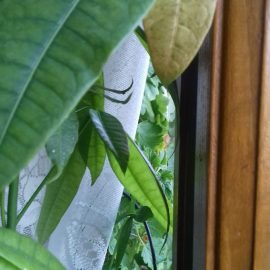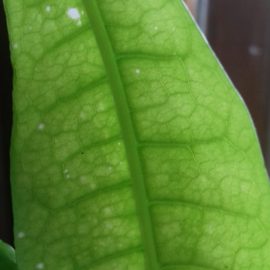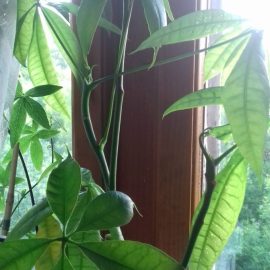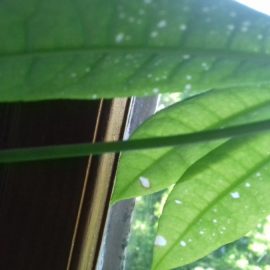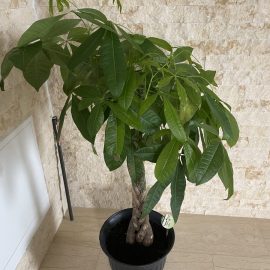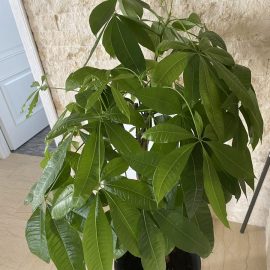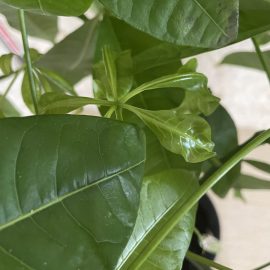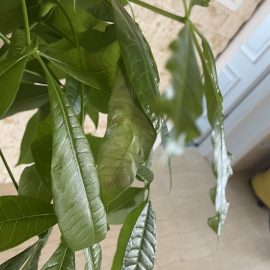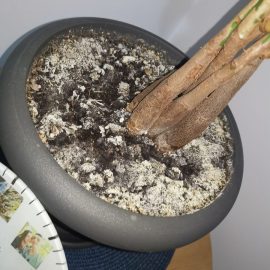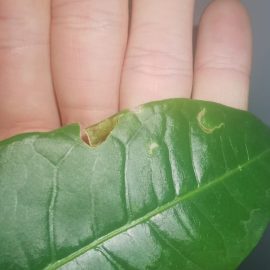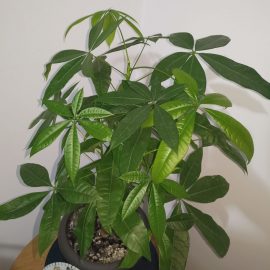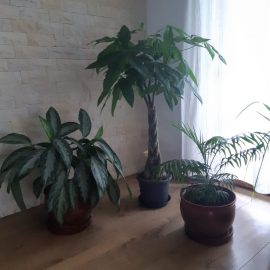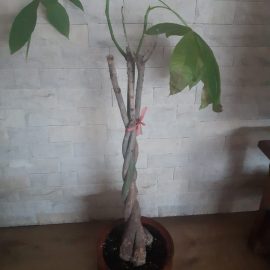Pachira, plant care and growing guide
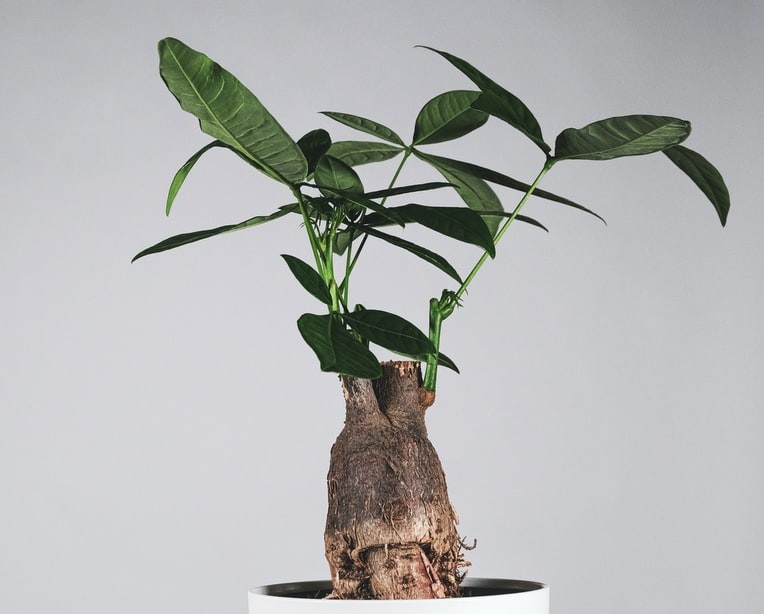
Pachira (Pachira aquatica) is a plant native to Central and South America. It is known as the Guyana chestnut or Money tree, due to some legends regarding the place of origin and to some superstitions related to the leaves and trunk of the plant.
It is a species that is used for ornamental purposes, as a potted plant. Although in tropical areas it can reach heights of 20 m, in pots it does not exceed 2-3 m. For decorative purposes, the flexible woody stems of the shrub can intertwine. The palmate, leathery and shiny leaves are arranged at the top of the tendrils on a petiole that is about 20 cm long.
It has large flowers, colored in yellow-green, red, white, or cream. The fruits are also large and have edible seeds, with a taste similar to chestnuts or hazelnuts. In pots, it does not bloom and it does not produce fruit.
Species
There are many species of Pachira, those grown for ornamental purposes in pots being Pachira aquatica and Pachira glabra. The two species are very similar.




Environmental conditions
Light. Pachira does not tolerate prolonged exposure to direct sunlight, but it grows well in bright or partially shaded places.
Temperature. The optimum temperature for the development of the plant is 15-25° C.
Humidity. It prefers high atmospheric humidity. In its absence, it is recommended to spray the crown and trunk with water.
Substrate. The substrate should be rich in organic matter. Universal soil mixed with peat, sand, and manure compost can be used.
Recommended products
-
You can find products on a different store
Change Store -
You can find products on a different store
Change Store -
You can find products on a different store
Change Store -
You can find products on a different store
Change Store -
You can find products on a different store
Change Store -
You can find products on a different store
Change Store -
You can find products on a different store
Change Store -
You can find products on a different store
Change Store -
You can find products on a different store
Change Store -
You can find products on a different store
Change Store -
You can find products on a different store
Change Store -
You can find products on a different store
Change Store -
You can find products on a different store
Change Store -
You can find products on a different store
Change Store -
You can find products on a different store
Change Store -
You can find products on a different store
Change Store -
You can find products on a different store
Change Store -
You can find products on a different store
Change Store -
You can find products on a different store
Change Store -
You can find products on a different store
Change Store -
You can find products on a different store
Change Store -
You can find products on a different store
Change Store -
You can find products on a different store
Change Store -
You can find products on a different store
Change Store
Pachira – Care
Watering. It should be done regularly, with sufficient amounts of water at longer intervals. The soil should be allowed to dry slightly on the surface before you water the plant again.
Fertilization. To maintain the healthy appearance of the plant, it is recommended to apply fertilizers suitable for decorative shrubs. No fertilizer should be applied in winter.
Recommended products
-
You can find products on a different store
Change Store -
You can find products on a different store
Change Store -
You can find products on a different store
Change Store -
You can find products on a different store
Change Store -
You can find products on a different store
Change Store -
You can find products on a different store
Change Store -
You can find products on a different store
Change Store -
You can find products on a different store
Change Store -
You can find products on a different store
Change Store -
You can find products on a different store
Change Store -
You can find products on a different store
Change Store -
You can find products on a different store
Change Store -
You can find products on a different store
Change Store -
You can find products on a different store
Change Store -
You can find products on a different store
Change Store -
You can find products on a different store
Change Store -
You can find products on a different store
Change Store -
You can find products on a different store
Change Store -
You can find products on a different store
Change Store -
You can find products on a different store
Change Store -
You can find products on a different store
Change Store -
You can find products on a different store
Change Store -
You can find products on a different store
Change Store -
You can find products on a different store
Change Store
Transplanting. It is recommended to replant it annually or once every 2-3 years, in spring.
Pruning. In order to obtain ornamental shrubs of low heights, the tops that are too high can be cut in spring or autumn. Stem shoots can be removed when necessary (when they cover the braided stems).
Recommended products
-
You can find products on a different store
Change Store -
You can find products on a different store
Change Store -
You can find products on a different store
Change Store -
You can find products on a different store
Change Store -
You can find products on a different store
Change Store -
You can find products on a different store
Change Store -
You can find products on a different store
Change Store -
You can find products on a different store
Change Store -
You can find products on a different store
Change Store -
You can find products on a different store
Change Store -
You can find products on a different store
Change Store -
You can find products on a different store
Change Store -
You can find products on a different store
Change Store -
You can find products on a different store
Change Store -
You can find products on a different store
Change Store -
You can find products on a different store
Change Store -
You can find products on a different store
Change Store -
You can find products on a different store
Change Store -
You can find products on a different store
Change Store -
You can find products on a different store
Change Store -
You can find products on a different store
Change Store -
You can find products on a different store
Change Store -
You can find products on a different store
Change Store -
You can find products on a different store
Change Store
Propagation. It can be made through seeds, cuttings, or stem shoots. Seedlings with 2-3 leaves should be cut from the mother plant in spring. Both the shoots and the cuttings are then placed in a jar of water or in the substrate.
Recommended products
-
You can find products on a different store
Change Store -
You can find products on a different store
Change Store -
You can find products on a different store
Change Store -
You can find products on a different store
Change Store -
You can find products on a different store
Change Store -
You can find products on a different store
Change Store -
You can find products on a different store
Change Store -
You can find products on a different store
Change Store -
You can find products on a different store
Change Store -
You can find products on a different store
Change Store -
You can find products on a different store
Change Store -
You can find products on a different store
Change Store -
You can find products on a different store
Change Store -
You can find products on a different store
Change Store -
You can find products on a different store
Change Store -
You can find products on a different store
Change Store -
You can find products on a different store
Change Store -
You can find products on a different store
Change Store -
You can find products on a different store
Change Store -
You can find products on a different store
Change Store -
You can find products on a different store
Change Store -
You can find products on a different store
Change Store -
You can find products on a different store
Change Store -
You can find products on a different store
Change Store
In addition, treatments can be applied to stimulate rooting.
Recommended products
-
You can find products on a different store
Change Store -
You can find products on a different store
Change Store -
You can find products on a different store
Change Store -
You can find products on a different store
Change Store -
You can find products on a different store
Change Store -
You can find products on a different store
Change Store -
You can find products on a different store
Change Store -
You can find products on a different store
Change Store -
You can find products on a different store
Change Store -
You can find products on a different store
Change Store -
You can find products on a different store
Change Store -
You can find products on a different store
Change Store -
You can find products on a different store
Change Store -
You can find products on a different store
Change Store -
You can find products on a different store
Change Store -
You can find products on a different store
Change Store -
You can find products on a different store
Change Store -
You can find products on a different store
Change Store -
You can find products on a different store
Change Store -
You can find products on a different store
Change Store -
You can find products on a different store
Change Store -
You can find products on a different store
Change Store -
You can find products on a different store
Change Store -
You can find products on a different store
Change Store
Diseases and pests. In case of excessive moisture of the substrate, pathogens can infect the plant, such as molds or fungi. Among the pests, specific for this plant are mites, especially the common red spider mite, which causes the formation of discolored spots on the leaves.
In addition:
- during the summer you can move it outside in a sheltered space;
- changing the location can affect the plant;
- excessive watering can cause root rot;
- the longevity of the potted plant is low, 2-5 years;
- the braiding of the stems is done on young plants, with flexible stems, not yet lignified. They are woven at the base and fixed with textile material at the base of the crown. During the growth of the stems, the procedure is repeated. The braided stems lignify and maintain their shape.














































































































































































































































































































































































































































